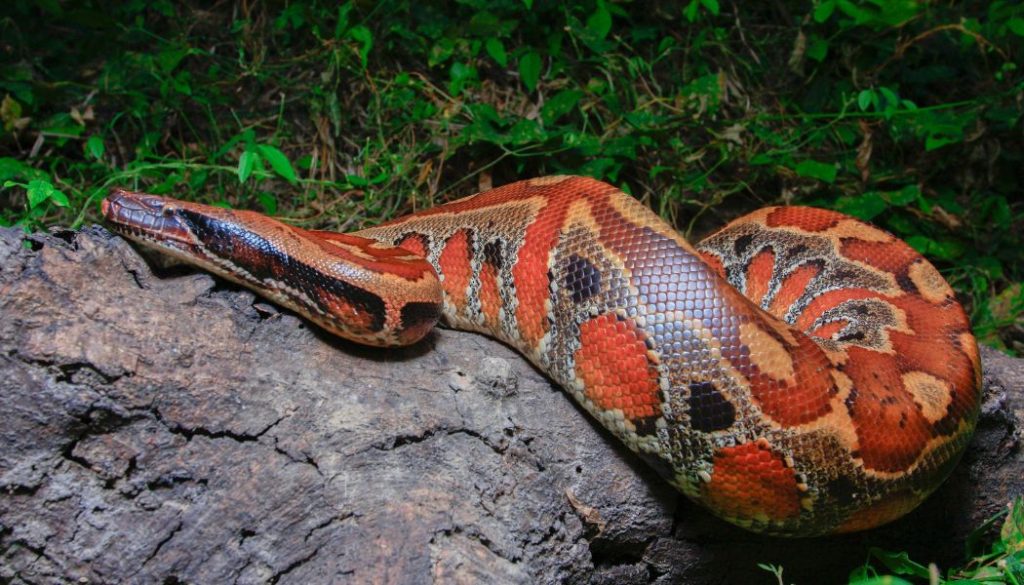Welcome to the fascinating world of blood pythons! In this article, we delve into the life expectancy of these remarkable reptiles, particularly focusing on how long they live in captivity compared to their wild counterparts.
Blood pythons in captivity typically live between 20 to 30 years, with some even surpassing this range under optimal care. This lifespan is generally longer than their average in the wild due to controlled living conditions and proper healthcare.
We explore various factors that significantly influence their lifespan, including diet, nutrition, common health issues, and the impact of breeding practices.
Additionally, we’ll touch on the signs of aging and provide insights into end-of-life care.
Whether you’re a seasoned herpetologist or simply curious about these intriguing creatures, this article offers a comprehensive guide to understanding the longevity of blood pythons in a captive environment.

Table of Contents
Average Lifespan in Captivity vs Wild
When we delve into the intriguing world of blood pythons, one of the most common questions that pop up is, “How long do blood pythons live in captivity?” Well, let’s unravel this mystery together.
In the wild, blood pythons, with their robust and fascinating presence, are estimated to have a lifespan of around 20 years. This figure, however, isn’t set in stone due to the variables of wild living, like predation and environmental stress.
Now, turn the page to captivity, and it’s a whole different story. These magnificent creatures can live longer, often surpassing the 25-year mark, with some even reaching the ripe age of 30!
But why the difference? It’s all about the environment. In captivity, blood pythons are like the pampered royalty of the reptile world. They’re shielded from predators, receive consistent and nutritious meals, and live in environments that are meticulously controlled for temperature and humidity. It’s like comparing a life in a secure, luxurious fortress to one in the unpredictable wilderness.
Take, for instance, the case of a blood python named Seraphina. In the wild, she would have faced numerous challenges, but in captivity, she’s thriving at 27 years old – a testament to the enhanced lifespan these snakes can achieve in a well-maintained habitat.
This disparity between wild and captive lifespans is not unique to blood pythons, though. It’s a common thread across many animal species where human intervention provides a more controlled and less hazardous living environment.
In essence, by mimicking their natural habitat and eliminating survival threats, we’re able to significantly extend the lives of these captivating reptiles.
Impact of Diet and Nutrition on Lifespan
Diving into the impact of diet and nutrition on the lifespan of blood pythons, it’s much like piecing together a puzzle. The right diet is a critical piece in ensuring they not only survive but thrive in captivity.
Blood pythons are notorious for their appetite, and their diet plays a pivotal role in their overall health and longevity. In the wild, their diet consists primarily of small mammals, fitting their role as ambush predators.
In captivity, however, their diet needs careful management to prevent common issues like obesity, which can significantly shorten their lifespan.
A balanced diet for a captive blood python typically includes pre-killed or frozen-thawed rodents, like mice or rats. It’s not just about what they eat, but how much and how often. Overfeeding can lead to a slew of health problems, whereas a well-regulated diet can be the key to a longer, healthier life.
Consider the case of a captive blood python named Apollo. By managing his diet with appropriately sized meals and maintaining a regular feeding schedule, his keepers have been able to avoid obesity-related issues, contributing to a healthier and potentially longer life.
Common Health Issues and How They Affect Lifespan
Blood pythons, like any other living creature, are susceptible to various health issues. Understanding these common ailments is crucial in ensuring a long and healthy life for these snakes in captivity.
Let’s explore some of the prevalent health problems and their impact on their lifespan.
- Respiratory Infections: Often caused by improper humidity or temperature levels, respiratory infections can significantly shorten a blood python’s lifespan. Symptoms include wheezing, mucus discharge, and difficulty breathing. Regular habitat maintenance and monitoring can help prevent these infections.
- Obesity: This is a common issue in captive blood pythons due to overfeeding or a diet that’s too rich. Obesity can lead to a host of health problems, including fatty liver disease and joint issues, ultimately reducing their lifespan.
- Parasitic Infestations: Internal parasites, like worms, and external parasites, like mites, can affect a blood python’s health. They can cause stress, malnutrition, and other health issues, all of which can reduce their lifespan if not treated promptly.
- Mouth Rot (Infectious Stomatitis): This bacterial infection, if left untreated, can spread and become life-threatening. It’s characterized by inflammation, pus, and sometimes bleeding in the mouth.
- Shedding Problems: Improper shedding, often due to low humidity, can lead to retained shed, which can cause infections and stress.
By addressing these health issues proactively and providing optimal care, owners can significantly enhance the quality and length of their blood pythons’ lives.
Breeding Practices and Their Effect on Lifespan
Breeding practices play a significant role in the health and lifespan of blood pythons. It’s a delicate balance: proper breeding can lead to healthier, longer-living snakes, while poor practices can have adverse effects.
Selective breeding in captivity can be beneficial, as it allows breeders to focus on health and temperament traits. This can lead to the development of blood python lines with fewer genetic health problems, which can increase their lifespan.
Additionally, captive breeding eliminates the stresses of living in the wild, such as predator threats and food scarcity.
However, there are potential downsides. Inbreeding, for instance, can lead to genetic health issues and a shorter lifespan. This is why responsible breeders often introduce new genetic lines to maintain a healthy gene pool.
Moreover, breeding females face additional health risks. Frequent breeding can lead to physical exhaustion and decreased health, impacting their lifespan. Responsible breeding practices, such as allowing sufficient rest between clutches and ensuring optimal health before breeding, are crucial.
Take the example of a breeding female named Athena. By ensuring she was only bred once every couple of years, her keepers could maintain her health and longevity, illustrating the importance of ethical breeding practices.
Signs of Aging and End-of-Life Care
As blood pythons age, several signs indicate they are entering their senior years. Understanding and recognizing these signs helps in providing them with appropriate end-of-life care.
Here’s a list of common aging signs in blood pythons:
- Decreased Activity: Older blood pythons often show reduced activity levels and may spend more time resting.
- Appetite Changes: Aging snakes might experience changes in appetite, often eating less than they did in their youth.
- Weight Loss or Gain: Unexpected weight changes, either loss or gain, can be a sign of aging and associated health issues.
- Duller Skin Coloration: The vibrant colors of a blood python may fade or become duller with age.
- Slower Shedding Process: The shedding process might become more challenging and slower in older snakes.
- Visible Signs of Wear: Scars or wear from a lifetime of activity may become more pronounced.
End-of-life care for blood pythons involves ensuring their comfort. This includes maintaining optimal habitat conditions, adjusting diet as needed, and providing a stress-free environment.
Regular veterinary check-ups are crucial to manage any age-related health issues effectively.
Conclusion
As you now understand, blood pythons can enjoy a long life of 20 to 30 years in captivity with proper care. Your role in providing a suitable environment, balanced diet, and addressing health concerns is crucial.
Remember, with your dedication and attention, you have the power to ensure a fulfilling and healthy life for your blood python.
Embrace this journey with confidence and commitment, and you’ll find the experience of caring for these magnificent creatures both rewarding and enriching.
FAQ
How long can a blood python live?
In captivity, blood pythons can live for an impressive 20 to 30 years, sometimes even longer with exceptional care. This lifespan is notably longer than their average in the wild, thanks to controlled environments, proper diet, and absence of predators.
Are blood pythons hard to care for?
Blood pythons are not particularly hard to care for, but they do require specific habitat conditions and dietary management to thrive. They need a warm, humid environment and a diet of appropriately-sized rodents. Regular health check-ups and a well-maintained enclosure are also essential. Their care needs make them better suited for someone with some experience in snake keeping.




0 Comments